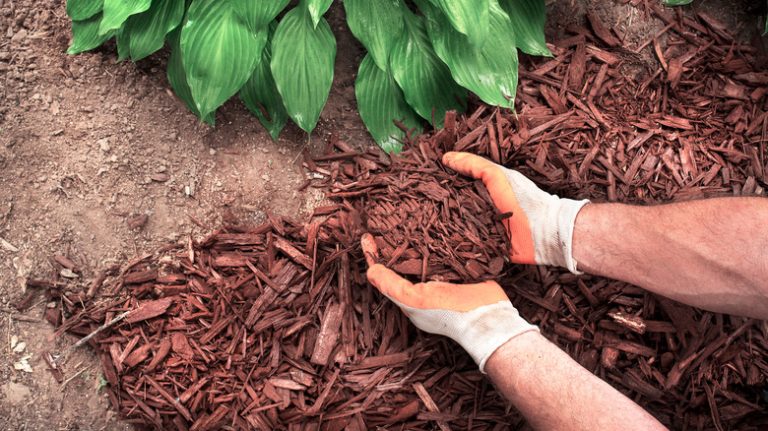If you’re trying to design the yard of your dreams or want to improve the look of your property, then you might be considering different plant options. You might be looking at hanging basket flowers for your porch or considering small trees that won’t overtake your yard. Maybe you’re tinkering with the idea of drought-resistant plants for your rock garden or looking at easy-to-grow beginner plants if you don’t quite have a green thumb yet. And if you’re looking for something truly decorative, you might be considering ornamental grasses for your yard.
Ornamental grass is a great way to add color to your yard, line your property, or fill in garden patches. Costa Farms describes ornamental grass as a “punctuation mark” in landscape design since it adds fun texture and color to the garden. A wide range of different ornamental grass can survive and thrive in various conditions, but the trick is to zero in on the kind that will work best with your particular property. Read on to find out about some of the most attractive ornamental grasses that could soon be growing in your yard.
1. Golden bamboo

You might not think of golden bamboo (scientific name Phyllostachys aurea) as grass, but it is! While it’s an attractive addition to any yard, it’s an especially great option for those looking to either create a barrier or privacy screen on their property. Golden bamboo can grow canes 1 to 2 inches thick and over 20 feet tall, according to The Spruce.
Bloom Season: only occasionally flowers
USDA Growing Zone: zone 6 to 10
Growing Conditions: partial shade
Soil Type: loose, slight acid, and well-drained
Size: 12 to 20 feet tall and 12 to 25 feet wide
2. Blue oat grass

You will adore the way blue oat grass (scientific name Helictotrichon sempervirens, Avena candida) looks in your yard, thanks to its striking blue-tinged leaves. What makes this plant even more attractive is that it will flower during the summer months, according to Gardening Know How.
Bloom Season: summer
USDA Growing Zone: zone 4 to 9
Growing Conditions: full sun
Soil Type: well-drained
Size: 2 to 3 feet tall and 2 to 3 feet wide
3. Pink muhly grass
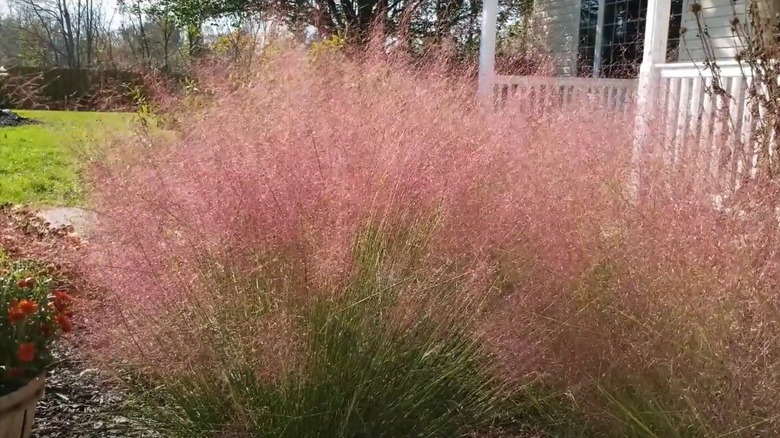
YouTube
Thanks to its fluffy, color-changing leaves, pink muhly grass (scientific name Muhlenbergia capillaris) brings lots of drama to a yard. According to The Spruce, this plant is a lovely shade of green during warmer months and takes on a rose-colored hue during fall.
Bloom Season: fall
USDA Growing Zone: zone 6 to 9
Growing Conditions: full sun or partial shade
Soil Type: well-drained
Size: 1 to 3 feet tall and 2 to 3 feet wide
4. Feather reed grass

Kathryn Roach/Shutterstock
If you’re looking for easy to care for grasses, Better Homes & Gardens suggests planting feather reed grass (scientific name Calamagrostis “Karl Foerster”) in your yard. Growing straight and sturdy, the narrow plants are topped off with a feathery crown that will stretch toward the sunny sky.
Bloom Season: summer
USDA Growing Zone: zone 4 to 9
Growing Conditions: full sun
Soil Type: well-drained
Size: 3 to 8 feet tall and 1 to 2 feet wide
5. Purple millet

Ketrin_Ti/Shutterstock
According to the University of Wisconsin-Madison, purple millet (scientific name Pennisetum glaucum) can also be called purple majesty, and it’s easy to see why. With bushy purple cattails popping out from the top of the plant and darker leaves growing beneath, the purple millet will add a dark pop to your property.
Bloom Season: mid-summer and into fall
USDA Growing Zone: zone 2 to 11
Growing Conditions: full sun or partial shade
Soil Type: well-drained
Size: 4 to 6 feet tall
6. Maiden grass

Peter Turner Photography/Shutterstock
Changing with the seasons, maiden grass (scientific name Miscanthus sinensis) boasts greens leaves and tops that flower in a copper color before turning white. While maiden grass brings a lot of style to a front yard, it’s important to note that it’s an invasive plant in some places in the United States, according to The Spruce. So make sure to check that it’s safe to plant in your region.
Bloom Season: late summer into fall
USDA Growing Zone: zone 5 to 9
Growing Conditions: full sun or partial shade
Soil Type: moist and well-drained
Size: 3 to 8 feet tall
7. Mexican feather grass

YouTube
According to Better Homes & Gardens, Mexican feather grass (scientific name Nessella tenuissima) thrives in hotter areas. It tends to sway in whatever breeze it catches thanks to its thin and super-fine blades, adding a whimsical touch to your yard. While it’s a fabulous option to plant in some states, it’s potentially invasive in others. Certain varieties are not ideal for specific regions, and require research before planting.
Bloom Season: summer
USDA Growing Zone: zone 6 to 10
Growing Conditions: full sun
Soil Type: dry soil
Size: 1 to 3 feet tall and up to 3 feet wide
8. Dwarf pampas grass
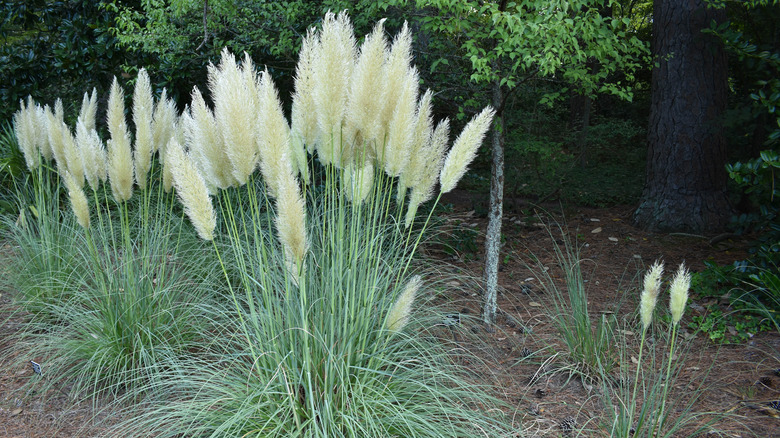
ShutterFlash/Shutterstock
While regular (and sometimes problematic) pampas grass can grow up to 10 to 13 feet tall and 6 feet wide, per HGTV, dwarf pampas grass (scientific name Cortaderia selloana “Pumila”) offers the same gorgeous growth in a smaller, more manageable size. Featuring strong stems, the plants hold up puffy white tops that can have soft hints of pink or a flash of silver.
Bloom Season: mid-summer
USDA Growing Zone: zone 6 to 10
Growing Conditions: full sun
Soil Type: well-drained
Size: 4 to 5 feet tall
9. Purple fountain grass
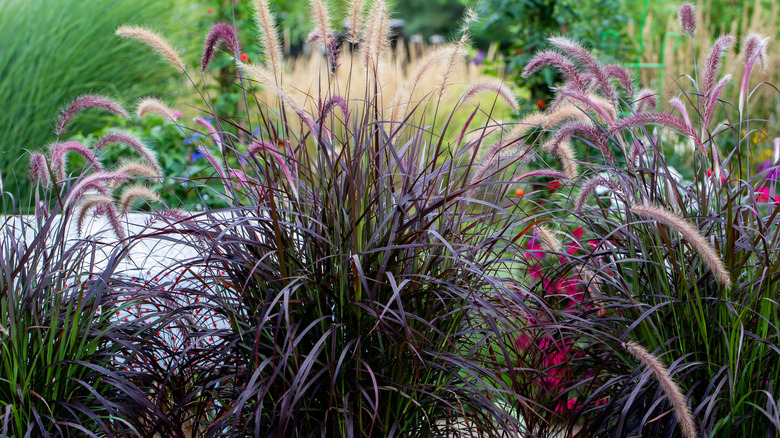
Molly Shannon/Shutterstock
Despite the name of purple fountain grass (scientific name Pennisetum setaceum “Rubrum”), The Spruce notes that it can take on a burgundy-red shade at times. It’s a particularly eye-catching plant since it mixes slender blade-like leaves with flowering stems that take on a fluffy shape.
Bloom Season: summer and fall
USDA Growing Zone: zone 9 to 10
Growing Conditions: full sun or partial shade
Soil Type: moist and well-drained
Size: 2 to 5 feet tall and 2 to 4 feet wide
10. Zebra grass

Fotoknips/Shutterstock
It’s not hard to figure out how zebra grass (scientific name Miscanthus sinensis “Zebrinus”) got its name. With green leaves that have yellowish-white stripes, the plant changes colors throughout the seasons. According to Gardenia, zebra grass will change from copper to tan throughout the colder months and sometimes grow large, bushy plumes that will change from a pinky-copperish tone to a striking silver.
Bloom Season: late summer
USDA Growing Zone: zones 5 to 9
Growing Conditions: full sun
Soil Type: does well in pretty much any kind of soil
Size: 5 feet tall and 5 feet wide
11. Orange or bronze New Zealand sedge

Nahhana/Shutterstock
Orange New Zealand sedge (scientific name Carex testacea) is a bold option for any yard, and it comes in many different varieties. According to Plant Care Today, it’s in a family with over 2,000 individual species! Although it doesn’t bloom with flowers or plumes, it does stick around throughout the year.
Bloom Season: not a blooming grass
USDA Growing Zone: zone 6 to 10
Growing Conditions: full sun or partial shade
Soil Type: loamy and well-drained
Size: 2 feet tall and 2 feet wide
12. Umbrella grass
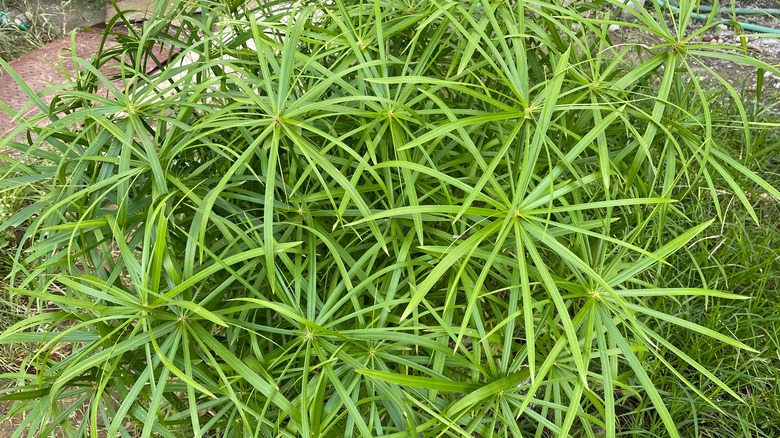
Debu Durllabh/Shutterstock
As Our House Plants explains, umbrella grass (scientific name Cyperus involucratus) is the kind of plant that can be grown both inside and outside. While it looks great in a living room, it’s also an excellent option for your yard, thanks to its unique shape. With a straight stem and leaves that burst open just like an umbrella, you’ll be sure to have neighbors asking about the eye-catching grass in your front yard.
Bloom Season: summer
USDA Growing Zone: zone 8 to 9
Growing Conditions: full sun
Soil Type: moist
Size: 2 to 6 feet tall
13. Japanese blood grass

YouTube
With its bright red color — which can turn into a deep scarlet shade — Japanese blood grass (scientific name Imperata cylindrical “Rubra”) may sound scary, but it’s a truly stunning plant. While you’ll want to avoid the invasive Imperata cylindrica version, you can instead opt for the Imperata cylindrical “Rubra” variety which won’t cause the same issues, according to The Spruce.
Bloom Season: doesn’t have a specific blooming time
USDA Growing Zone: zone 5 to 9
Growing Conditions: full sun or partial shade
Soil Type: moist and well-drained
Size: 1 to 2 feet tall
14. Little bluestem grass

Michael G McKinne/Shutterstock
With cool-toned blades that shoot out in almost every direction, little bluestem (scientific name Schizachyrium scoparium) will make a big impact wherever you decide to plant it. The grass grows up to 3 feet tall, but when it blooms flowers, the stalks extend the plant by another foot or so, per Gardenista.
Bloom Season: mid to late summer
USDA Growing Zone: zone 4 to 9
Growing Conditions: full sun
Soil Type: well-drained
Size: 3 feet tall
15. Egyptian papyrus

topimages/Shutterstock
Similar to umbrella grass (Cyperus involucratus), Egyptian papyrus (scientific name Cyperus papyrus) is a palm-like plant that is a popular choice among ornamental grasses. Not only is it strikingly tall, but The Spruce explains that it can even produce flowers and fruit.
Bloom Season: mid to late summer
USDA Growing Zone: zone 8 to 11
Growing Conditions: full sun
Soil Type: rich and wet
Size: 5 to 8 feet tall and 2 to 4 feet wide


